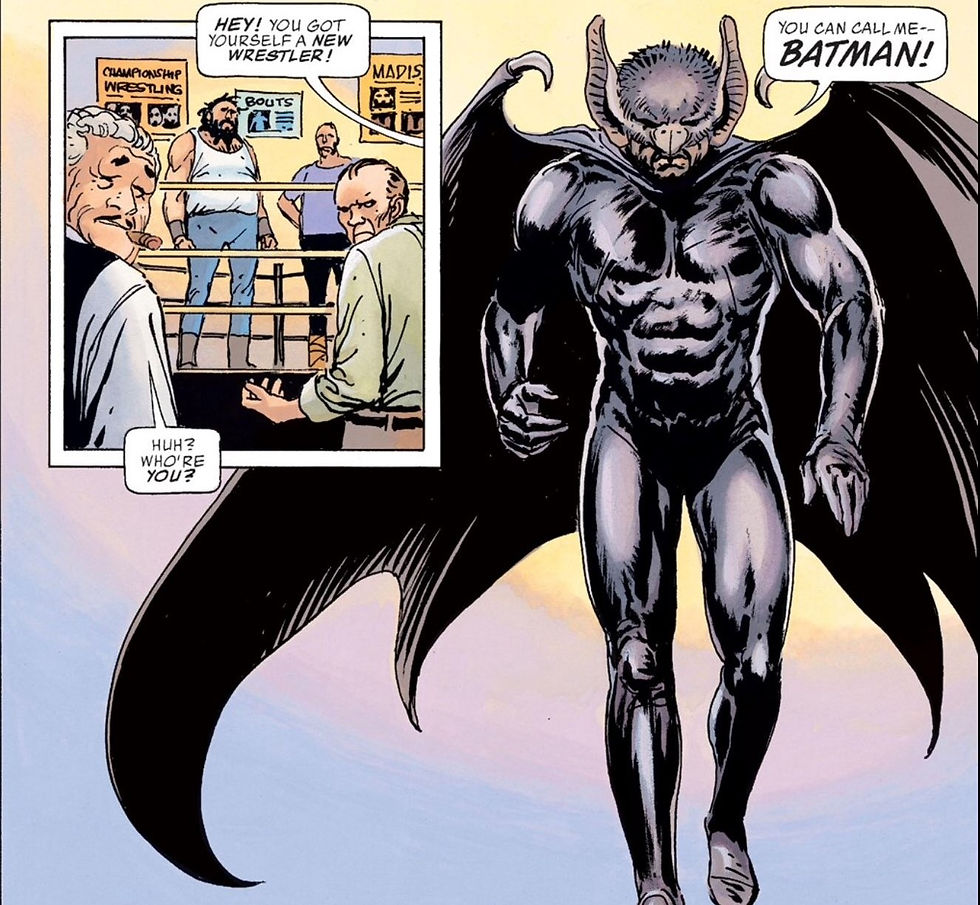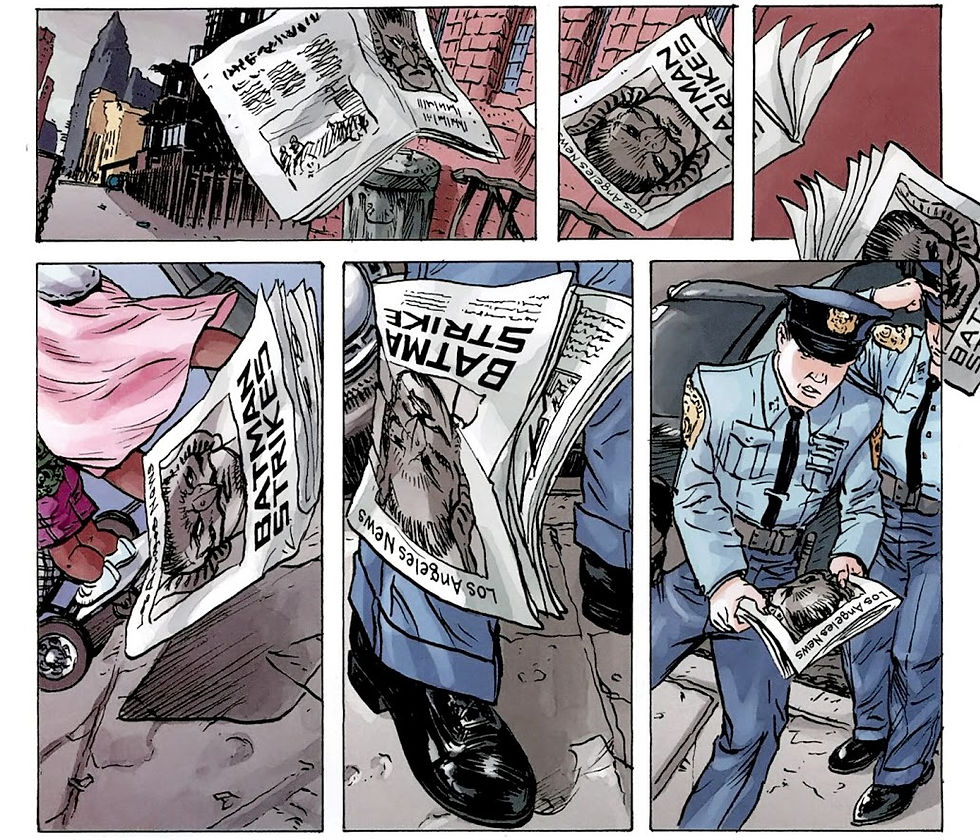POST 174 --- JUST IMAGINE... BATMAN BY STAN LEE
- Scott Cresswell
- May 15, 2022
- 7 min read
I suppose to some uneducated and ignorant folk, Stan Lee created everything to do with comic books. Of course, this judgement is fundamentally flawed; Lee’s career was only at Marvel, and he was only one innovative creator of many who founded the comic’s universe of characters (albeit a major creator). However, as the face of comic books to much of the public and many fans alike, Stan Lee became something of a celebrity. His shameless self-promotion and charming egotism had made Stan Lee different from any other comic book writer or creator. He even became renowned for his cameo appearances in Marvel’s cinematic releases until his death in 2018 at the age of 95. Since this year will mark the centenary of Lee’s birth, I thought I’d select

something, well, different. Lee may have been the driving force behind Marvel, but did you know that, once upon a time lost in the dark vaults of comic book history, he worked for his biggest rival DC Comics?
Just Imagine: Batman, published in September 2001, was written by Stan Lee with art by Joe Kubert. The book also features a back-up story written by Michael Uslan with art by Mike Kaluta. I’ve read the stories in the original graphic novel.
Just Imagine… was a product of its time. It was from an era when DC Comics and Marvel were, just about, getting along creatively. The previous decade had been extremely rocky between the two companies as the mood between executives and editors was hugely personal and reeked of animosity. But in the early 2000s, some cooperation emerged as it appeared that the newly founded Image Comics would, one day, rule as the medium’s most successful publisher. The famous JLA/Avengers crossover miniseries is a classic example of this as Kurt Busiek and George Perez (God rest his soul) took part in a major story which linked to the two universes of heroes together. Just Imagine… was a similar expedition. It was essentially Stan Lee’s take on the DC Universe. It has been reported by many comics journalists and historians that DC, in a state of crisis, paid Lee one million dollars to write his versions of Batman, Wonder Woman, Superman, Green Lantern, The Flash, the JLA, Robin, Captain Marvel, Aquaman, Catwoman, and the Sandman, along with a Secret Files and Origins tale. For this review, I’ve chosen Lee’s Batman story because, honestly, it’s the only one I own, and it will probably always remain that way. So, this is Stan Lee writing Batman. Well, ‘writing’ is perhaps not the right choice of words. In the grim rainy night, Wayne Williams stands over the grave of his father, with his mother present. Already, you can see the differences with Lee’s version. Wayne Williams, unlike Bruce Wayne, is poor and his father was a cop who was killed in-action. Things continue to go wrong for Wayne as Gotham is overrun with violence and death. One day, even worse luck arrives on his doorstep. A crime lord named Handz is walking on the street near the shop where Wayne works. However, the crime boss is nearly killed in a drive-by shooting, but Wayne manages to rescue Handz’s beaten girlfriend. The crime boss doesn’t take this heroism well as he attacks and threatens Wayne, telling him that he will return. That day comes when Handz’s gang frames Wayne for killing his boss and he is sent to prison. There, the story takes a rudimentary path. Wayne is attacked in prison as he is weak, but over time, this changes as he dominates the prison’s gym. He also befriends a doctor who acts as a kind of mentor to Wayne, but he leaves prison and tells Wayne to meet him when he is released. At the same time, Wayne learns that his mother has died. So, the hero is down on his luck, things get bad, and he begins to work out. Welcome to Spiderman! Wayne even begins to become friends with a bat in prison. Yes, that is no metaphor or joke. Wayne befriends a bat. I suppose that’s the one aspect which relates Wayne William’s character to Bruce Wayne. Meanwhile in the outside world, Handz is invading the underworld and becoming the face of Gotham’s crime network. If Stan Lee wanted to make Handz into a memorable villain for this story, then he has failed. In the mainstream comics, Batman has ended up with several crime boss foes and, for the most part, all of them almost merge into one. For instance, Maroni, Falcone, and Thorne are too similar in their characters and aims to actually register in my heads. Maybe that explains why Lee introduces a new and more mysterious element. In the Church of Eternal Empowerment, Reverend Dominic Darrk preaches immortality, and he pledges that his following will grow. At the exact same moment, the prison guard in Wayne’s jail opens all the cells. An army of criminals emerge and fight for their escape. However, Wayne Williams, with his new set of morals, rescues the prison warden from near-death and somehow defeats the army of delinquents. With that, Wayne is awarded his parole and Handz is far from happy. We’re well-over the half-way mark with his story and Lee is following every laborious step in the book. This formula would have worked in the 1960s when most characters lacked a personality and much drama, but four decades on, this isn’t at all imaginative or really unique. It’s just the origin of a Marvel hero with a bat involved. Either way, Wayne leaves prison with his pet bat (God knows how he snuck that out of jail), and he puts his efforts into amateur boxing. Okay, maybe that was unexpected. What makes him a (continued)

unique fighter is his homemade bat-costume. In Lee’s world, Batman really does look like a human bat. It may look silly both in practice and as an idea, but he essentially looks like a heroic version of Man-Bat. Either way, Batman makes a name for himself and somehow ends up on cereal boxes as a money-making mascot. All of this, however, have been baby-steps in order to achieve his core goal: to defeat Handz. With the help of that crazy professor from prison (who basically become another Alfred), Wayne’s hero costume is augmented to include flying abilities along with bullet-proof Kevlar. With that, the moment we’ve all be waiting for happens. Batman heads to Handz’s penthouse and, in short, kills him. As a result, Batman rescues Handz’s girlfriend once again from danger, although she isn’t too happy about his death. Somehow, Batman sees her in his future. Why? Because that is how comics used to work back in Stan Lee’s day. As the main villain falls (literally), what of Dominic Darrk. His cult learns of Batman as a new heroic force and he orders his followers to destroy him. Yep, that is where it ends. I believe that the cultist storyline is an ongoing aspect to the Just Imagine… series, but I wish they could have featured in a more direct way. Although he fills the role as villain, Handz just isn’t very memorable or interesting. There is definitely something interesting to the cult that I wish Lee could have explored more here. Perhaps now is the best time to mention that when I refer to Lee, I’m referring to whoever wrote this story. It may have his name in the credits, but from what I can gather, he didn’t write a word of this. In a very Stan Lee-fashion, he spoke with the artist, Joe Kubert, or perhaps an editor, and told him a general and very basic outline of the plot. From there, all effort was placed into the hands of others. Whatever view you hold of Stan Lee’s work at Marvel and whether his creative powers were as large and dominating as he himself believed, there is a consensus with his DC work that Lee’s involvement was very limited. In essence, this was a money-making exercise, and not a particularly fun one. It’s just a plain Elseworlds story with very little originality. I do like Wayne Williams as a character and his backstory is interesting, but it’s nothing new for superhero comics. Really, he could have become any hero after the death of his father. Unlike Bruce Wayne, Wayne Williams isn’t alone in the shadows in the same way that Bruce becomes. His origin is very public and open. Originality and cliché are undoubtedly the story’s main problems. Because there is nothing new, there is little to be excited about. Even the dialogue, some of which may or may not be penned by Lee, is tired and extremely silver age. With this clear lack of effort and originality, it’s clear that this story only exists because Stan Lee wanted even more money.
At least the art has some more merits than the writing. Joe Kubert is an odd choice to pencil a story such as this one. He was known more for pencilling war comics decades before, but his art here fits the tone of the story I suppose. It’s grim and dark, but very rushed and messy at times. But that style has always been Joe Kubert to me. His layouts are certainly more updated than Stan Lee’s writing as the story is dramatic and looks visually strong. It’s just the finishes which weaken the story really. I don’t mind it looking grim or even a bit scratchy at times, but like the story, the art looks clumsy and rushed.
The Back-Up – On The Street
For reasons which aren’t really clear, all of these Just Imagine… graphic novels had back-up stories. This one, titled On The Street, is only four pages and written by Michael Uslan with art by Mike Kaluta. It’s a very basic and simple story; a newspaper featuring Batman on the front page makes its way through the city with the help of the wind. Along the way, it is picked up by police, gangsters, and children. I suppose (continued)

the point of it is to show that Batman is almost legendary and can strike fear into everyone. But other than that, there really isn’t much else to say about the story. I guess they had to do something with four pages, and this was the best they could produce. Kaluta’s art is somewhat scratchy, but overall it fits the moodiness of Gotham.
VERDICT
Overall, nobody should remember Just Imagine… as a series, and certainly not Lee’s Batman’s story. His writing and themes might have been more relevant and powerful in the 1960s, but the world in early 21st century was radically different. Lee’s story may have some areas of intrigue, but the style is totally wrong, and the writing lacks any relevance or purpose. It’s a cliché-ridden mess. The art may give the story a decent visual appearance, but it doesn’t look like a huge amount of effort has gone into it, or even the back-up tale. Overall, it’s a novelty item that really didn’t deserve to make as much money as it did.
Story: 3/10
Art: 5.5/10
Next Week: DC Universe Legacies (DC Universe Legacies 1-10). Written by Len Wein with art by Scott Kollins, Andy Kubert, Joe Kubert, J.G. Jones, J.H. Williams III, Jose Luis Garcia-Lopez, Dave Gibbons, George Perez, Scott Koblish, Walt Simonson, Jerry Ordway, Keith Giffen, Al Milgrom, Dan Jurgens, Brian Bolland, Frank Quitely, Jesus Saiz, Karl Story, Robin Riggs, Bill Sienkiewicz, Tom Dorenick, Gary Frank, and Jon Sibal.




Comments